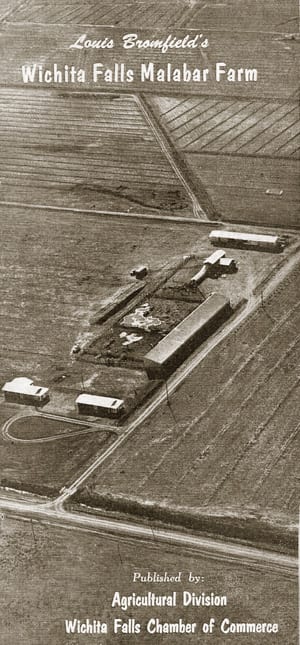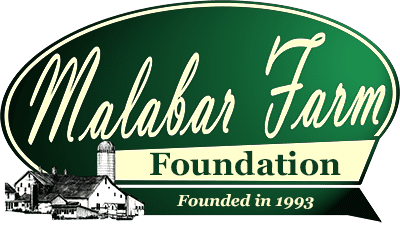Article Contribution
The following is a history of Malabar Farm, Wichita Falls (Texas). This article was written by Jim Shade from information, news articles, and documents provided by Robert Cole Huge, son of Robert W. Huge. The brochure image of Malabar Farm, Texas was provided by Robert Cole Huge.

In early 1949, at the urging of Lloyd Noble, wealthy Oklahoma oil man and founder of Samuel Noble Foundation, Louis Bromfield and his long time farm manager Robert W. (Bob) Huge agreed to start a Malabar Experimental Farm in Wichita County, Texas. The site of this new Malabar Farm would be developed on a 411 unimproved piece of ground 16 miles southwest of Wichita Falls, Texas. This property had been given to the Wichita County Chamber of Commerce by the Rufus King family in hopes it could be used to somehow stimulate development in the Area.
The soils on this 411 acres were badly depleted of nutrients and ranged from a clay based soil so hard a normal farm tractor of its time couldn’t begin to break up the hard pan to a sandy loam. Over the years there had been oil exploration leaving behind several old oil settling ponds. Several spots had been used to raise sudan grass for hay, but mostly had been abandoned and mesquite bush allowed to randomly cover the fields.
Farms in this part of Texas don’t get enough annual rainfall to produce dependable crops so they must use some type of irrigation system. In this area flood irrigation was used and there was a watershed district in place that allocated water rights to the properties.
On March 31, 1949, The First National Bank of Wichita Falls, Texas issued a check, based on a promissory note from Bromfield and Huge, for $10,275.00 to the Chamber of Commerce as payment in full for this 411 acre parcel of land. The Buyers did not get any mineral rights to the property, only surface rights, and there was a provision that if in seven years the buyers failed to develop the property into a working experimental farm operation, its ownership would revert back to the Chamber. The original stated use for the property was that it would be a truck farm (ie. vegetables) and a dairy operation with supporting hay and pasture land.
In a matter of days after the closing, work began on the property. Crews began building two identical 2 bedroom homes on concrete slabs. Also there were livestock corrals, an elevated stanchion milk parlor, a shaded shelter barn for the cattle, and a large open-sided building for equipment and hay storage being constructed. Out in the fields, crews were bulldozing scrub brush and leveling pits and other surface irregularities.
The next operation was a Louis Bromfield inspired function. A very large self propelled diesel powered Seamans roto tiller had been purchased (or donated) and was breaking up the hard pan surface that existed over much of the farm land area. This was followed up with land leveling and ditching in preparation for the flood irrigation system. By late fall of 1949 much had been accomplished and soon cattle for the milking herd began to arrive at the farm.
While this work was going on, Bob Huge and his family moved from Ohio to Ardmore, Oklahoma, 110 miles up the road from their farm. Huge divided his time between supervising the farm’s progress and special assignments for the Agricultural Department of the Noble Foundation. The announcement of the coming of Malabar Texas Farm elevated Mr. Bromfield and Mr. Huge to near celebrity status in that part of the country. They were constantly being asked to speak at service clubs, colleges, Noble Foundation and other agricultural events. While Louis Bromfield never took up residency in the area, he made numerous trips to the region to comply with speaking requests; especially ones fostered by Lloyd Noble with whom he had become a very close friend. Robert Huge, who was 37 years old at the time was so impressive to the Noble Foundation he became a paid executive officer in addition to his duties with Malabar Texas.
A January 1, 1950 grand opening for Malabar Farm Texas was held and it created much interest and excitement though out the region. The Farm was staffed up and everything was in place, for the most part, to start the first real year of operation.
Then on February 14, 1950, an event occurred that eventually would cause the unraveling of the up- start Texas operation. Lloyd Noble died unexpectedly. Without Mr. Noble’s influence, relations with the local leadership began to deteriorate. The first conflict that arose was the farm’s allocation of irrigation water rights in 1950 were far less than was needed to produce a suitable hay crop to feed the dairy herd. Malabar was forced to go on the open market for hay which was in short supply due to a dry season in the southwest. A 50 pound bale of hay was costing $1.00 per bale, twice the going rate at that time. Feed grains were also in short supply and very expensive as well. Bottom line was that with 150 Holstein milk cows to feed, it cost nearly as much for the feed than the milk production was worth.
During 1950 and 1951 it was discovered that the farm’s soil was severely deficient of trace nutrients and had a high salt content. Also it was discovered that the irrigation water they did get was high in salt content along other with other contaminants. The reason for the salt problem was not readily known but may have been related to improper disposing of salt brine which is a by product of oil production. There was, or had been, a significant amount of this activity in the area.
In April 1951 trouble was brewing at the Noble Foundation. Col. F. J. Wilson, who was appointed as managing trustee, upon Lloyd Noble’s death, was at odds with other trustees, some being members of Lloyd Noble’s family, and asked to resign. This left Bob Huge in an uncomfortable position at the Foundation so he too elected to resign his position at the Foundation and announced he was moving to “Little Malabar” (Texas), as he called it, to devote full time attention to the Farm operations.
By late 1951 and early 1952, the conflict with the Wichita Falls city fathers/chamber was hitting a high point. They were claiming that the farm was no show place, like the Ohio Malabar Farm, as they had hoped for and that the crops were inferior to what neighboring farmers raised. Louie Bromfield responded that it was never intended to be a fancy place like Ohio Malabar but a basic functional dairy farm. He also was constantly complaining about the lack of irrigation water that the farm was getting. All this made for interesting news stories in the local newspaper. Bromfield seriously felt that the Texas group had no real interest in agricultural endeavors or experimentation. Their prime motivation in Malabar Texas was to use it as a catalyst for rural development of the area and hence raise surrounding land values.
On February 15, 1952 an interesting real estate transfer occurred. Louis Bromfield and Robert W. Huge transferred a 1/3 undivided interest in the 411 acre farm to R.F. (Roger) Culler. It turns out that Roger Culler was a local Lucas, Ohio friend and cattle herdsman who had been making periodic visits to Malabar Texas relative to the health of the 150 head Holstein dairy herd. This had been done by Mr. Culler since the cattle arrived but he had never charged the farm for his services. Giving Culler the 1/3 interest was Bromfield and Huge’s way of paying him for his previous services rendered, and up to $10,000 for services yet to be provided.
The Wichita Falls Chamber of Commerce on July 22, 1952 filed suit to revert title of the 411 acres plus $50,000 damages against Bromfield, et al. Bromfield filed a counter suit of $20,000 in damages to recover monies spent on the Texas operation. About this same time Robert W. Huge and family moved back to Malabar Farm in Ohio. Huge resumed working there as the farm manager and had little to no involvement with Malabar Texas other than an occasional legal deposition. Bromfield also ceased any active operating involvement in early 1953. He cash rented the property to J.L. Reeve who moved into one of the farm houses and actively farmed the land.
For the next year and a half much legal wrangling took place but nothing significant to resolving the dispute until a trial started on February 8, 1954. The trial included Louis Bromfield’s testimony along with many expert witnesses from the plaintiff’s side. The whole thing ended in a hung jury on February 19, 1954.
After this was more legal wrangling and a new trial date of June 14, 1954 was established. Prior to the start of the second trial attorneys for both parties got everyone together and they worked out a deal that both sides accepted and presented to the trial judge for the court’s approval. On June 7, 1954 the proposed settlement whereby Bromfield et al got to keep the 1954 cash rents for the farm and the renter had until October 1, 1954 to remove crops and vacate the buildings. They also got a payment of $15,000 damages from the Chamber and $3000 due from an insurance company for damages to a building. The Chamber in turn got free and clear title back for the 411 acres. As to the milking herd, it is not documented, so one must assume it was liquidated sometime in the last half on 1952. Most likely the Ferguson TO30 tractors were hauled away by a dealer of Harry Ferguson Co. who had loaned them to the farm.
I’m sure that as it turned out, Bromfield, Huge and later Mr. Culler wished they had never seen Malabar Farm Texas or Wichita Falls, Texas. But no doubt always wondered “what might have been” had Lloyd Noble not passed away when he did and had been around to serve as the farm’s guardian. Use link below for more information on the Malabar Farm-Texas
https://www.mansfieldnewsjournal.com/story/news/history/2014/09/06/malabar-farm-texas/15205271/
